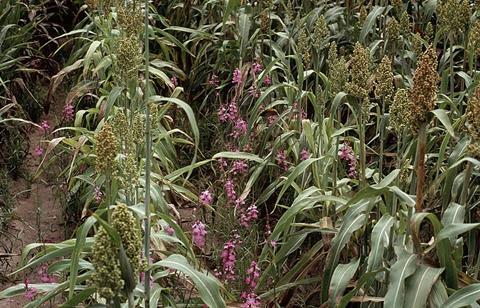A research team identified potential Striga-suppressing rhizobacteria associated with sorghum, which have been shown to significantly reduce Striga seed germination rates.

This study highlights the value of soil-borne bacteria as bioherbicides to control Striga, a parasitic weed of cereal crops, offering a sustainable and accessible solution for smallholder farmers. Future applications could involve the isolation and characterization these rhizobacteria to enhance sorghum productivity in Sub-Saharan Africa.
READ MORE: Researchers identify microbes that help plants thwart parasite
READ MORE: Research unveils rhizobia strains effective against soybean root rot fungal pathogens
The most effective isolates, mainly from the Pseudomonas genus, demonstrate promising biocontrol potential against Striga, with the potential to transform sorghum agriculture in low-input farming systems.
Sorghum (Sorghum bicolor (L.) Moench), a vital cereal crop, thrives in semi-arid tropics and supports more than 500 million people globally. Despite its importance, sorghum productivity is hindered by abiotic factors like drought and biotic factors including the parasitic weed Striga. In Ethiopia, these challenges significantly impact yields, and current Striga control methods are often impractical or unaffordable for low-income farmers.
Sustainable and accessible
A research article (DOI: 10.48130/tia-0024-0008) published in Technology in Agronomy on 04 June 2024, aims to identify specific rhizobacteria capable of suppressing Striga infestation, providing a sustainable and accessible solution for improving sorghum productivity in Ethiopia.
To identify Striga-suppressive rhizobacteria, 117 bacterial isolates were collected from the rhizosphere of 12 sorghum varieties in three regions of Ethiopian. These isolates were screened for hydrogen cyanide (HCN) and indole-3-acetic acid (IAA). Of the isolates, 47 produced HCN to varying degrees of potency, while 22 produced IAA.
Twenty-one isolates were common producers of both HCN and IAA, and these were further tested for their effects on Striga hermonthica germination. In vitro assays revealed significant germination inhibition, with the lowest germination rates (0%, 1%, and 2.7%) observed in isolates E19G12, E29G2b, and E19G10, respectively.
Further characterization revealed that these effective isolates belonged to the genera of Pseudomonas, Bacillus, Klebsiella, and Enterobacter, highlighting their potential as bioherbicides to combat Striga infestations in sorghum.
Potential bioherbicides
According to the study’s lead researcher, Urgesa Tsega Tulu: “The results of the study demonstrated the existence of promising soil-borne bacteria that could be exploited as bioherbicides to control Striga infestation on sorghum provided that broader samples from various parts of the country are explored.”
In summary, this study identified rhizobacteria isolates capable of significantly suppressing Striga germination in sorghum, with isolates E19G12, E29G2b, and E19G10 being the most effective. These findings highlight the potential of using rhizobacteria as environmentally friendly bioherbicides. Future research should focus on broader isolation and characterization of these bacteria to enhance their application in controlling Striga, ultimately improving sorghum productivity for smallholder farmers in Ethiopia.







No comments yet